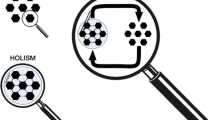Abstract
Development of simulation approach to study social processes is strongly correlated to progress in computer technology. The increasing computational power of modern computers and increasing possibilities of graphic representation allows simulation with more adequate metaphors and analogies to real processes. One of the leading branches of economic analysis applying the simulation approach is evolutionary economics, but even within this field of research the importance of simulation is not uniform. The following section of the article deals with the use of the simulation approach in analysing and understanding real phenomena. Problems of model testing and validation are also described in this section. In the third section a short analysis of the role played by simulation in evolutionary economics is presented. A variety of simulation approaches to analysing economic development are presented in the fourth section. Two main streams of models, namely those rooted in Schumpeterians tradition and the agent-based approach, are characterized. Working out a so-called common platform (i.e., software which would be able to model economic development and can be used both by economists skilled in computer programming and those not familiar with it) is being pursued at the moment. In the last section three propositions about such common platform are briefly discussed.
Access this chapter
Tax calculation will be finalised at checkout
Purchases are for personal use only
Preview
Unable to display preview. Download preview PDF.
Similar content being viewed by others
References
Boulding K.E.: 1991, ‘What is evolutionary economics?’. Journal of Evolutionary Economics 1, 9–17.
Bruckner, E., Ebeling, W., Jimenez Monta, o M.A., Scharnhorst, A.: 1993, ‘Technological Innovations A Self- Organisation Approach’. Wissenschaftszentrum Berlin für Socialfroschung, FS II 93–302.
Andersen, Esben Sloth: 1997, ‘Escaping Satiation in an Evolutionary Model of Structural Economic Dynamics’. Paper presented at the workshop on Escaping Satiation: Increasing Product Variety, Preference Change and the Demand Side of Economic Growth, Max Planck Institute for Research into Economic Systems, Jena.
Chiaromonte F., Dosi G.: 1993, ‘Heterogeneity, competition, and macroeconomic dynamics’. Structural Change and Economic Dynamics 4, 39–63.
Dosi, G., Marsili, O., Orsenigo, L., Salvatore, R.: 1993, ‘Learning, Market Selection and the Evolution of Industrial Structures’. Center for Research in Management, University of California at Berkeley, CCC Working Paper No. 93–9.
Dosi, G., Fabiani, S., Aversi, R. and Meacci, M.: 1994, ‘The Dynamics of International Differenti-ation: A Multi-country Evolutionary Model’. Industrial and Corporate Change 2, 225–41.
Eliasson, Gunnar: 1985, The Firm and Financial Markets in the Swedish Micro-to-Macro Model. Theory, Model and Verification. Stockholm: Almmvist & Wiksell International.
Eliasson, Gunnar: 1989, ‘Modelling Long-term Macroeconomic Growth as a micro-based, path dependent, experimentally organized economic process’. Working paper, The Industrial Institute for Economic and Social Research, Stockholm.
Epstein, Joshua M, Axtel,l Robert: 1996, Growing Artificial Societies: Social Science from the Bottom Up. Brookings Institution Press: MIT Press.
Jay W. Forrester: 1971, ‘Counterintuitive Behavior of Social Systems’. Technology Review.
Hodgson, Geoffrey: 1993, Economics and Evolution: Bringing Life Back into Economics. Cambridge: Polity Press.
Hodgson, G. M.: 1996, ‘The Challenge of Evolutionary Economics’. first version, contribution to a collection of ‘views and comments on economics and evolution’ for the Journal of Institutional and Theoretical Economics.
Kaldor N.: 1961, ‘Capital Accumulation and Economic Growth’. In: F. Lutz (ed.), The Theory of Capital,London: Macmillan.
Kwaśnicka, H., Kwaśnicki, W.: 1992, ‘Market, Innovation, Competition. An evolutionary model of industrial dynamics’. Journal of Economic Behavior and Organization 19, 343–68.
Kwaśnicki, W.: 1996, Knowledge, Innovation, and Economy. An Evolutionary Exploration. Cheltenham: Edward Elgar Publishing Limited.
Kwaśnicki W.: 1996, ‘Ekonomia ewolucyjna — alternatywne spojrzenie na proces rozwoju gospodarczego’. in Gospodarka Narodowa, nr. 10 (part 1) and 11 (part 2).
Law Averill, M., Kelton, W. David: 1982, Simulation Modeling and Anaysis. McGraw-Hill.
Marimon, R., McGrattan, E., Sargent, T.: 1990, ‘Money as a medium of exchange in an economy with artificial intelligent agents’. Journal of Economic Dynamics Control 14, 329–373.
Nelson, R.R., and Winter, S.G.: 1982, An Evolutionary Theory of Economic Change. Cambridge: Belknap Press.
Poincaré, Henri: 1952, Science and Hypothesis. New York: Dover.
Silverberg, Gerald: 1985, ‘Technical Progress, Capital Accumulation and Effective Demand: A Self-organisation Model’. In: D. Batten (ed.), Economic Evolution and Structural Change, Berlin-Heidelberg-New York: Springer-Verlag.
Silverberg, Gerald and Lehnert, Doris: 1993, ‘Long Waves and ‘Evolutionary Chaos’ in a Simple Schumpeterian Model of Embodied Technical Change’. Structural Change and Economic Dynamics 4, 9–37.
Silverberg, Gerald, Verspagen, Bart: 1995, ‘Economic Dynamics and Behavioral Adaptation: An Application to an Evolutionary Endogenous Growth Model’. IIASA Working paper WP-94–84.
Silverberg, Gerald, Verspagen, Bart: 1995, ‘An Evolutionary Model of Long Term Cyclical variations of Catching Up and Falling Behind’. IIASA Working paper WP-95–09.
Taylor, Paul: 1995, ‘Modelling Artificial Stock markets Using Genetic Algorithms’. In: Suran Goonatilake and Philip Treleaven (eds.), Intelligent Systems for Finance and Business, New York: Wiley.
Winter, S.G.: 1984, ‘Schumpeterian Competition in Alternative Technological Regimes’. Journal of Economic Behavior and Organization 5, 287–320.
Winter, S.G., Kaniovski, Y. M., Dosi, G.: 1997, ‘A Baseline Model of Industry Evolution’. IIASA Working Report IR-97–013.
Valente, Marco: 1997, ‘Laboratory for Simulation Development’. User Manual, IIASA Working Paper, IR-97–020/May.
Editor information
Editors and Affiliations
Rights and permissions
Copyright information
© 1999 Springer Science+Business Media New York
About this chapter
Cite this chapter
Kwaśnicki, W. (1999). Evolutionary Economics and Simulation. In: Brenner, T. (eds) Computational Techniques for Modelling Learning in Economics. Advances in Computational Economics, vol 11. Springer, Boston, MA. https://doi.org/10.1007/978-1-4615-5029-7_1
Download citation
DOI: https://doi.org/10.1007/978-1-4615-5029-7_1
Publisher Name: Springer, Boston, MA
Print ISBN: 978-1-4613-7285-1
Online ISBN: 978-1-4615-5029-7
eBook Packages: Springer Book Archive




